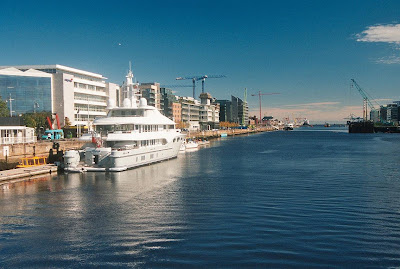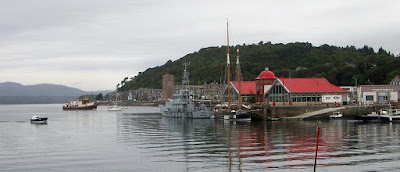The Scilly Isles consist of 48 Islands separated by sandy rock-strewn channels. Their position in the Southwestern corner of the United Kingdom affords them the benefit of warm weather transported by the gulf stream, but at a cost of being exposed to the full force of the Atlantic weather.
We arrived in New Grimsby Sound which is quite a sheltered place to stay in terms of swell and wind. It was used in 1942 as a base for mock French fishing boats which would take on reconnaissance missions to the French coast. Their mission was very important as the information they gathered helped to prepare for the D-Day landings. I digress…. We spent a couple of days exploring Tresco which is a very pretty island, with well tended gardens full of tropical plants spilling out over the stone walls. There are no cars on the island. Instead, those who don’t use their legs get around in golf-cart type vehicles. The experience was made all the better as summer seemed to have arrived, giving us beautiful hot days. We even spent an afternoon sunbathing on a deserted beach next to Cromwell’s Castle. In October!!
Separating New Grimsby Sound from St. Mary’s, the main Island, are Tresco Flats. These are about a mile of sand flats that dry, that is to say that at low tide you can walk around. Not good news for a boat with a draught of 1.8m. As well as the sand, there are also quite a few rocks to avoid, but our pilotage guide makes the point that most of these rocks are “friendly”, as they are distinctive and can be used for navigation. So we made a trace of the chart, marking the relevant transits and bearings on it and headed off in the dinghy quite close to low water, across the flats. We followed the same route as we would go in Lady Ayesha, which worked fine and gave us confidence to do it for real.
Craig continued on to St. Marys, and dropped me off at Tresco Abbey Gardens. These are beautiful gardens with more than 4000 original plants. Many of the exotic plants were originally brought here by Scillonian Master Mariners returning from their travels. There is also the Valhalla Museum which contains numerous figureheads from the many ships that have been wrecked (and salvaged) on the shores of these islands.
Craig returned later with supplies and news of the French who we had met in Dublin. The next day they joined us in New Grimsby Sound and came over for dinner, which was good fun, and quite fortunate for them too as they had just run out of cooking gas.
The harbour master had given us a good deal on the mooring, so we stayed a couple more days than we had planned. We eventually headed off at the top of the tide across the Tresco Flats, without any problems and over to St. Mary’s Pool next to Hugh Town where we picked up a mooring buoy. We were told that in summer you cannot get a buoy for love nor money as it is so busy. Hugh Town is another lovely town, and what struck me was the amount of bird song. The air was positively alive with the buzz of birds singing in the palm trees and lush gardens. They also seem to be very tame. When we went for a walk we noticed they didn’t scatter as we approached them, they just carried on with what they were doing. We even hand fed a Song Thrush and some Blackbirds. Our walk took us past the Garrison, built during the civil war, across Porth Cressa Beach and around Peninnis Head with its peculiar rock formations to Old Town where we brought ice creams, as the weather had miraculously stayed hot. We had a packed lunch in the sublime Carrag Dhu Gardens which we had to ourselves, except for the friendly birds. One sentence in the Channel Pilot we are using would not get out of my head, it follows: “Buy some bulbs for your garden and keep your holiday for years” So as we passed Sunnydale farm which had an assortment of bulbs for sale, we just had to get some, ignoring the fact that we don’t have a garden.

Hugh Town moorings, St Mary's
Porth Cressa, St Mary's
That evening just before the sun set, with all its glorious pinks and purples and oranges which reflect in the calm waters, we motored off and dropped the hook in the pinch (Porth Congar) between Gugh and St. Agnes. As anchorages go, this is not particularly sheltered, but the weather has been so benign that it was possible to stay here for a couple of days quite comfortably. We walked around St. Agnes in the afternoon, which is a great place just to relax. On the way we passed Beady Bay, so named as a cargo of red & black Viennese beads from a ship wrecked on nearby rocks was washed up here. The western side of the island, near St. Warnes Bay offers spectacular views of the Western Rocks, which today looked so striking against the bright sky, but must be terrifying on a stormy night. By the way, St. Warnes is the patron saint of Shipwrecks. It would seem that Admiral Sir Clowdisley was not praying to the right saint on the foggy night of October 22nd 1707, for his ship, The Association and three other navy ships struck the outlying rocks and sank to the bottom like stones- with the loss of 2000 lives. The Admiral actually survived and was washed ashore where he was found by an old Scillonian lady (no doubt with a beautiful garden). However the old lady fell in love with the emerald ring on his finger, and promptly murdered him for it! The simple reason that they hit the rocks was because they did not know how far east or west they were as the question of longitude had not yet been resolved. The sinking of the Association catapulted the longitude question into the forefront of national affairs and eventually lead to the Longitude Act of 1714 in which parliament promised a prize of £20,000 for a solution.
Briefly, lines of latitude were derived from the movements of the sun, moon and stars, and therefore could be easily calculated with celestial navigation, however the placing of the lines of longitude was a political decision. Hence why the Greenwich Meridian line (0 degrees longitude) runs through London (the French didn’t like this by the way and used to refer to it as “Paris Mean Time, retarded by 9 minutes twenty-one seconds“). To learn one’s longitude at sea, you need to know exactly what time it is aboard the ship and exactly what time it is in a reference port. So what was needed was an accurate clock, that would keep time in a rolling, wet, hot/cold ship. If you want to know the end of this fascinating story that stumped natural philosophers & the like and changed the world, read Longitude by Dava Sobel. Nowadays we have GPS, which is frankly amazing when you think about what it actually does.
Gugh looking over the bar to St Agnes
Western Rocks
Anyway, so the Scillies in the right weather are a gorgeous semi-tropical paradise with lush gardens, turquoise sea, and white sandy beaches, in fact the perfect place to chill out and read a book before heading home to Brighton, just watch out for those old ladies with an eye for jewellery…
























































